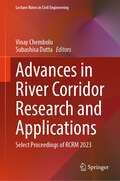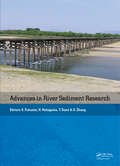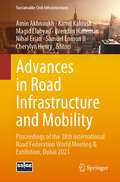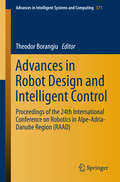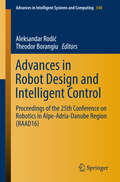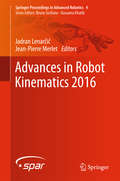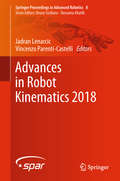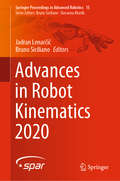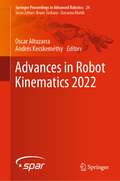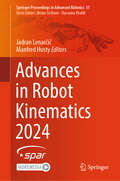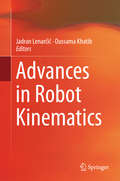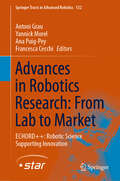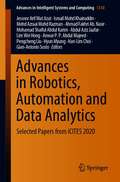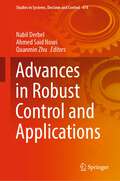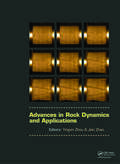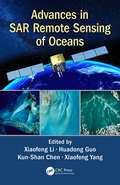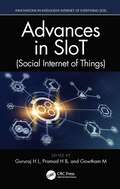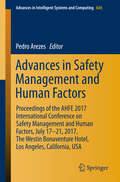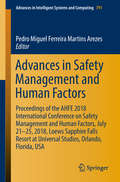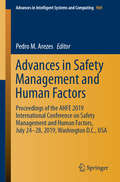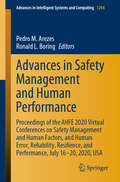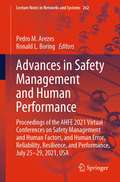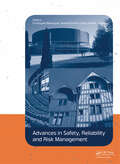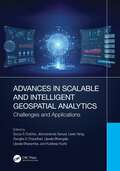- Table View
- List View
Advances in River Corridor Research and Applications: Select Proceedings of RCRM 2023 (Lecture Notes in Civil Engineering #470)
by Subashisa Dutta Vinay ChemboluThis book presents the select proceedings of the 3rd International Conference on River Corridor Research and Management (RCRM 2023). It describes various topics on fluvio-hydro-ecological processes of river systems. The topics covered include river dynamics and morphological changes, river health and ecological aspects and satellite remote sensing for river corridor studies. The book also discusses the morphological behavior of gravel and sand-bed rivers, hydrological and hydraulics modeling and other important aspects of riverine ecology. The book will be a valuable reference for researchers and professionals working in the areas of river science.
Advances in River Sediment Research
by Hao Zhang Tetsuya Sumi Shoji Fukuoka Hajime NakagawaThis book covers recent accomplishments in theoretical developments, numerical simulations, laboratory experiments, field investigations and management methodologies of river sediment related issues, and may serve as a reference book for graduate students, researchers, engineers and practitioners in disciplines of hydraulic, environmental, agricultural and geological engineering.
Advances in Road Infrastructure and Mobility: Proceedings of the 18th International Road Federation World Meeting & Exhibition, Dubai 2021 (Sustainable Civil Infrastructures)
by Amin Akhnoukh Kamil Kaloush Magid Elabyad Brendan Halleman Nihal Erian Samuel Enmon II Cherylyn HenryThis volume focuses on recent advances in the planning, design, construction and management of new and existing roads with a particular focus on safety, sustainability and resilience. It discusses field experience through case studies and pilots presented by leading international subject-matter specialists. Chapters were selected from the 18th International Road Federation World Meeting & Exhibition, Dubai 2021.
Advances in Robot Design and Intelligent Control: Proceedings of the 24th International Conference on Robotics in Alpe-Adria-Danube Region (RAAD) (Advances in Intelligent Systems and Computing #371)
by Theodor BorangiuThis volume includes the Proceedings of the 24th International Conference on Robotics in Alpe-Adria-Danube Region, RAAD 2015, which was held in Bucharest, Romania, on May 27-29, 2015. The Conference brought together academic and industry researchers in robotics from the 11 countries affiliated to the Alpe-Adria-Danube space: Austria, Croatia, Czech Republic, Germany, Greece, Hungary, Italy, Romania, Serbia, Slovakia and Slovenia, and their worldwide partners. According to its tradition, RAAD 2015 covered all important areas of research, development and innovation in robotics, including new trends such as: bio-inspired and cognitive robots, visual servoing of robot motion, human-robot interaction, and personal robots for ambient assisted living. The accepted papers have been grouped in nine sessions: Robot integration in industrial applications; Grasping analysis, dexterous grippers and component design; Advanced robot motion control; Robot vision and sensory control; Human-robot interaction and collaboration; Modelling and design of novel mechanisms and robotic structures; Robots in medicine and rehabilitation; Tracking systems and Unmanned Aerial Vehicles; Autonomous task learning, motion planning and scheduling.
Advances in Robot Design and Intelligent Control: Proceedings of the 25th Conference on Robotics in Alpe-Adria-Danube Region (RAAD16) (Advances in Intelligent Systems and Computing #540)
by Theodor Borangiu Aleksandar RodićThis book presents the proceedings of the 25th International Conference on Robotics in Alpe-Adria-Danube Region, RAAD 2016 held in Belgrade, Serbia, on June 30th-July 2nd, 2016. In keeping with the tradition of the event, RAAD 2016 covered all the important areas of research and innovation in new robot designs and intelligent robot control, with papers including Intelligent robot motion control; Robot vision and sensory processing; Novel design of robot manipulators and grippers; Robot applications in manufacturing and services; Autonomous systems, humanoid and walking robots; Human-robot interaction and collaboration; Cognitive robots and emotional intelligence; Medical, human-assistive robots and prosthetic design; Robots in construction and arts, and Evolution, education, legal and social issues of robotics. For the first time in RAAD history, the themes cloud robots, legal and ethical issues in robotics as well as robots in arts were included in the technical program. The book is a valuable resource for researchers in fields of robotics, engineers who implement robotic solutions in manufacturing, services and healthcare, and master's and Ph. D. students working on robotics projects.
Advances in Robot Kinematics 2016 (Springer Proceedings in Advanced Robotics #4)
by Jadran Lenarčič Jean-Pierre MerletThis book brings together 46 peer-reviewed papers that are of interest to researchers wanting to know more about the latest topics and methods in the fields of the kinematics, control and design of robotic systems. These papers cover the full range of robotic systems, including serial, parallel and cable-driven manipulators, both planar and spatial. The systems range from being less than fully mobile, to kinematically redundant, to over-constrained. In addition to these more familiar areas, the book also highlights recent advances in some emerging areas: such as the design and control of humanoids and humanoid subsystems; the analysis, modeling and simulation of human-body motions; mobility analyses of protein molecules; and the development of machines that incorporate man.
Advances in Robot Kinematics 2018 (Springer Proceedings in Advanced Robotics #8)
by Jadran Lenarcic Vincenzo Parenti-CastelliThis is the proceedings of ARK 2018, the 16th International Symposium on Advances in Robot Kinematics, that was organized by the Group of Robotics, Automation and Biomechanics (GRAB) from the University of Bologna, Italy.ARK are international symposia of the highest level organized every two years since 1988. ARK provides a forum for researchers working in robot kinematics and stimulates new directions of research by forging links between robot kinematics and other areas.The main topics of the symposium of 2018 were: kinematic analysis of robots, robot modeling and simulation, kinematic design of robots, kinematics in robot control, theories and methods in kinematics, singularity analysis, kinematic problems in parallel robots, redundant robots, cable robots, over-constrained linkages, kinematics in biological systems, humanoid robots and humanoid subsystems.
Advances in Robot Kinematics 2020 (Springer Proceedings in Advanced Robotics #15)
by Jadran Lenarčič Bruno SicilianoThis book is of interest to researchers wanting to know more about the latest topics and methods in the fields of the kinematics, control and design of robotic systems. The papers cover the full range of robotic systems, including serial, parallel and cable-driven manipulators. The systems range from being less than fully mobile, to kinematically redundant, to over-constrained. The book brings together 43 peer-reviewed papers. They report on the latest scientific and applied achievements. The main theme that connects them is the movement of robots in the most diverse areas of application.
Advances in Robot Kinematics 2022 (Springer Proceedings in Advanced Robotics #24)
by Andrés Kecskeméthy Oscar AltuzarraThis book reports on the latest scientific achievements on robot kinematics provided by the prominent researchers participating in the 18th International Symposium on Advances in Robot Kinematics ARK2022, organized in the University of the Basque Country, Bilbao, Spain. It is of interest to researchers wanting to know more about the latest topics and methods in the fields of the kinematics, control and design of robotic systems. The book brings together 53 peer-reviewed papers. These cover the full range of robotic systems, including serial, parallel, flexible mechanisms, and cable-driven manipulators, and tackle problems such as: kinematic analysis of robots, robot modelling and simulation, theories and methods in kinematics, singularity analysis, kinematic problems in parallel robots, redundant robots, cable robots, kinematics in biological systems, flexible parallel manipulators, humanoid robots and humanoid subsystems.
Advances in Robot Kinematics 2024 (Springer Proceedings in Advanced Robotics #31)
by Manfred Husty Jadran LenarčičThis book is aimed at researchers specializing in the kinematics of robot mechanisms as well as at doctoral students in guiding their research work. A spectrum of the latest achievements in kinematics analysis, modelling, simulation, design and control is covered. New theories and methods are applied to serial, parallel and cable-driven mechanisms for use in industrial or service robotics. The systems range from being less than fully mobile to kinematically redundant and over-constrained. Forty-nine papers are included, arranged in seven chapters, as presented at the 19th Symposium on Advances in Robot Kinematics 2024. The symposium, which has been held since 1988, was organized this time in Ljubljana (Slovenia), where it began thirty-six years ago. The papers have been rigorously selected based on peer review and are arranged in chapters randomly, as is the prevailing tradition of these symposia. In doing so, we aim to give equal emphasis to each of these achievements.
Advances in Robot Kinematics: Mechanisms And Motion (Springer Proceedings In Advanced Robotics Ser. #4)
by Jadran Lenarčič Oussama KhatibThe topics addressed in this book cover the whole range of kinematic analysis, synthesis and design and consider robotic systems possessing serial, parallel and cable driven mechanisms. The robotic systems range from being less than fully mobile to kinematically redundant to over constrained. The fifty-six contributions report the latest results in robot kinematics with emphasis on emerging areas such as design and control of humanoids or humanoid subsystems. The book is of interest to researchers wanting to bring their knowledge up to date regarding modern topics in one of the basic disciplines in robotics, which relates to the essential property of robots, the motion of mechanisms.
Advances in Robotics Research: ECHORD++: Robotic Science Supporting Innovation (Springer Tracts in Advanced Robotics #132)
by Antoni Grau Yannick Morel Ana Puig-Pey Francesca CecchiIn this book Part I presents first an overview of the ECHORD++ project, with its mission and vision together with a detailed structure of its functionalities and instruments: Experiments, Robotic Innovation Facilities and Public end-user Driven Technology Innovation PDTI. Chapter 1 explains how the project is born, the partners, the different instruments and the new concept of cascade funding projects. This novelty made ECHORD++ a special project along the huge number of research groups and consortia involved in the whole project. So far, it is the European funded project with more research team and partners involved in the robotic field. In Chapter 2, one of the instruments in ECHORD++ is explained in detail: RIF. Robotic innovation facilities are a set of laboratories across Europe funded with the project with the goal of hosting consortia involved in any experiment that have special needs when testing their robotic research. In the chapter the three different and specific RIFs will be described and analyzed. Chapter 3 explains an important instrument in ECHORD++: the Experiments. In this part, a big number of research groups have been involve in short time funded research projects. The chapter explains the management of such Experiments, from the call for participation, the candidate’s selection, the monitoring, reviews and funding for each of the 36 experiments funded for Echord. Chapter 4 is very special because it presents the innovation of funding public end-user driven technology, in particular, robotic technology. The robotic challenge is the key of such an instruments together with the management of the different consortia that participated competitively in the success of the robotic challenge proposed by a public entity, selected also with a very special and innovative process.
Advances in Robotics, Automation and Data Analytics: Selected Papers from iCITES 2020 (Advances in Intelligent Systems and Computing #1350)
by Hyun Myung Han-Lim Choi Anwar P. P. Abdul Majeed Mohd Azraai Mohd Razman Gian-Antonio Susto Jessnor Arif Mat Jizat Mohamad Shaiful Abdul Karim Ismail Mohd Khairuddin Ahmad Fakhri Ab. Nasir Abdul Aziz Jaafar Lim Wei Hong Pengcheng LiuThis book presents essentially a collection of proceedings that deliberate on the key challenges and recent trends on robotics, automation and data analytics which are the pillars of Industry 4.0. Solutions that are employed in the multitude spectra of innovative robotics & automation and data analytics are discussed. The readers are expected to gain an insightful view on the current trends, issues, mitigating factors as well as solutions from the book. This book consists of selected papers presented at the 2nd International Conference on Innovative Technology, Engineering and Sciences 2020 (iCITES) hosted virtually by Universiti Malaysia Pahang on 22nd December 2020. iCITES is a biennial conference, aimed at building a platform that allows relevant stakeholders to share and discuss their latest researches, ideas and survey reports from theoretical to a practical standpoint especially in the Innovative Robotics & Automation and Data Analytics tracks which was published in this book.
Advances in Robust Control and Applications (Studies in Systems, Decision and Control #474)
by Quanmin Zhu Nabil Derbel Ahmed Said NouriThe book presents recent applications and developments in the field of control of industrial systems, covering a wide range of modeling and feedback control using various robust approaches such as fuzzy systems, sliding mode control, and H-infinity. This book provides insights into theory, applications, and perspectives relevant to the field of robotic systems, exoskeletons, power systems, photovoltaic systems, etc., as well as general methodologies and paradigms around them. Each chapter provides an enriched understanding of a research topic along with a balanced treatment of the relevant theories, methods, or applications. It reports on the latest advances in the field. This book is a good reference for graduate students, researchers, educators, engineers, and scientists and contains a total of 15 chapters divided into five parts as follows. The first part of this book focuses on the application of fuzzy control to robotic systems and consists of three chapters. The second part of this book proposes the control of lower and upper limb exoskeletons and includes two chapters. The third part is dedicated to the control of power systems and comprises three chapters. The fourth part deals with various approaches to the modeling and control of industrial processes and comprises four chapters. The fifth and final part describes observers and fault-tolerant control systems and comprises five chapters.
Advances in Rock Dynamics and Applications
by Jian Zhao Yingxin ZhouThe study of rock dynamics is important because many rock mechanics and rock engineering problems involve dynamic loading ranging from earthquakes to vibrations and explosions. The subject deals with the distribution and propagation of loads, dynamic responses, and processes of rocks and rate-dependent properties, coupled with the physical environm
Advances in Rotor Dynamics, Control, and Structural Health Monitoring: Select Proceedings of ICOVP 2017 (Lecture Notes in Mechanical Engineering)
by Subashisa Dutta Santosha Kumar Dwivedy Esin InanThis book consists of selected and peer-reviewed papers presented at the 13th International Conference on Vibration Problems (ICOVP 2017). The topics covered in this book are broadly related to the fields of structural health monitoring, vibration control and rotor dynamics. In the structural health monitoring section studies on nonlinear dynamic analysis, damage identification, viscoelastic model of concrete, and seismic damage assessment are thoroughly discussed with analytical and numerical techniques. The vibration control part includes topics such as multi-storeyed stacked tuned mass dampers, vibration isolation with elastomeric mounts, and nonlinear active vibration absorber. This book will be useful for beginners, researchers and professionals interested in the field of vibration control, structural health monitoring and rotor dynamics.
Advances in SAR Remote Sensing of Oceans
by Xiaofeng Li, Huadong Guo, Kun-Shan Chen and Xiaofeng YangThe oceans cover approximately 71% of Earth’s surface, 90% of the biosphere and contains 97% of Earth’s water. Since the first launch of SEASAT satellite in 1978, an increasing number of SAR satellites have or will become available, such as the European Space Agency’s ERS-1/-2, ENVISAT, and Sentinel-1 series; the Canadian RADARSAT-1/-2 and the upcoming RADARSAT Constellation Mission series satellites; the Italian COSMO-SkyMed satellites, the German TERRASAR-X and TANDEM-X, and the Chinese GAOFEN-3 SAR, among others. Recently, European Space Agency has launched a new generation of SAR satellites, Sentinel-1A in 2014 and Sentinel-1B in 2016. These SAR satellites provide researchers with free and open SAR images necessary to carry out their research on the global oceans. The scope of Advances in SAR Remote Sensing of Oceans is to demonstrate the types of information that can be obtained from SAR images of the oceans, and the cutting-edge methods needed for analysing SAR images. Written by leading experts in the field, and divided into four sections, the book presents the basic principles of radar backscattering from the ocean surface; introduces the recent progresses in SAR remote sensing of dynamic coastal environment and management; discusses the state-of-the-art methods to monitor parameters or phenomena related to the dynamic ocean environment; and deals specifically with new techniques and findings of marine atmospheric boundary layer observations. Advances in SAR Remote Sensing of Oceans is a very comprehensive and up-to-date reference intended for use by graduate students, researchers, practitioners, and R&D engineers working in the vibrant field of oceans, interested to understand how SAR remote sensing can support oceanography research and applications.
Advances in SIoT (Innovations in Intelligent Internet of Everything (IoE))
by H L Gururaj H B Pramod M GowthamThe Social Internet of Things (SIoT) has become a hot topic in academic research. It employs the theory of social networks into the different levels of the Internet of Things (IoTs) and has brought new possibilities for the development of IoTs. Essentially, the SIoT is a subset of IoTs. It uses intelligent hardware and humans as the node, a social network as the organization type, the social relationship between things, things and humans, and between humans, formatting research methods and models with social network characteristics to realize the connection, service, and application of the IoTs. Moreover, SIoT is a form of realization of technology, architecture, and application of the IoTs using social network research methods. It further promotes the integration between real-world and virtual cyberspace, contributes the realization of the IoTs, expands the research scope of the social networking, and provides a new solution for the specific problems of the IoTs. Consequently, there is a tremendous need for researchers to have a comprehensive knowledge of the advances in SIoT. This special issue is soliciting scientific research papers that can present a snapshot of the latest research status of SIoT.
Advances in Safety Management and Human Factors: Proceedings of the AHFE 2017 International Conference on Safety Management and Human Factors, July 17–21, 2017, The Westin Bonaventure Hotel, Los Angeles, California, USA (Advances in Intelligent Systems and Computing #604)
by Pedro ArezesThis book discusses the latest findings on ensuring employees' safety, health, and welfare at work. It combines a range of disciplines - e. g. work physiology, health informatics, safety engineering, workplace design, injury prevention, and occupational psychology - and presents new strategies for safety management, including accident prevention methods such as performance testing and participatory ergonomics. The book, which is based on the AHFE 2017 International Conference on Safety Management and Human Factors, held on July 17-21, 2017, in Los Angeles, California, USA, provides readers, including decision makers, professional ergonomists and program managers in government and public authorities, with a timely snapshot of the state of the art in the field of safety, health, and welfare management. It also addresses agencies such as the Occupational Safety and Health Administration (OSHA) and the National Institute for Occupational Safety and Health (NIOSH), as well as other professionals dealing with occupational safety and health.
Advances in Safety Management and Human Factors: Proceedings of the AHFE 2018 International Conference on Safety Management and Human Factors, July 21-25, 2018, Loews Sapphire Falls Resort at Universal Studios, Orlando, Florida, USA (Advances in Intelligent Systems and Computing #791)
by Pedro Miguel ArezesThis book discusses the latest findings on ensuring employees’ safety, health, and welfare at work. It combines a range of disciplines – e.g. work physiology, health informatics, safety engineering, workplace design, injury prevention, and occupational psychology – and presents new strategies for safety management, including accident prevention methods such as performance testing and participatory ergonomics. The book, which is based on the AHFE 2018 International Conference on Safety Management and Human Factors, held on July 21–25, 2018, in Orlando, Florida, USA, provides readers, including decision makers, professional ergonomists and program managers in government and public authorities, with a timely snapshot of the state of the art in the field of safety, health, and welfare management. It also addresses agencies such as the Occupational Safety and Health Administration (OSHA) and the National Institute for Occupational Safety and Health (NIOSH), as well as other professionals dealing with occupational safety and health.
Advances in Safety Management and Human Factors: Proceedings of the AHFE 2019 International Conference on Safety Management and Human Factors, July 24-28, 2019, Washington D.C., USA (Advances in Intelligent Systems and Computing #969)
by Pedro M. ArezesThis book discusses the latest findings on ensuring employees’ safety, health, and welfare at work. It combines a range of disciplines – e.g. work physiology, health informatics, safety engineering, workplace design, injury prevention, and occupational psychology – and presents new strategies for safety management, including accident prevention methods such as performance testing and participatory ergonomics. The book, which is based on the AHFE 2019 International Conference on Safety Management and Human Factors, held on July 24-28, 2019, Washington D.C., USA, provides readers, including decision makers, professional ergonomists and program managers in government and public authorities, with a timely snapshot of the state of the art in the field of safety, health, and welfare management. It also addresses agencies such as the Occupational Safety and Health Administration (OSHA) and the National Institute for Occupational Safety and Health (NIOSH), as well as other professionals dealing with occupational safety and health.
Advances in Safety Management and Human Performance: Proceedings of the AHFE 2020 Virtual Conferences on Safety Management and Human Factors, and Human Error, Reliability, Resilience, and Performance, July 16-20, 2020, USA (Advances in Intelligent Systems and Computing #1204)
by Ronald L. Boring Pedro M. ArezesThis book brings together studies broadly addressing human error and safety management from the perspectives of various disciplines, and shares the latest findings on ensuring employees’ safety, health, and welfare at work. It combines a diverse range of disciplines – e.g. work physiology, health informatics, safety engineering, workplace design, injury prevention, and occupational psychology – and presents new strategies for safety management, including accident prevention methods such as performance testing and participatory ergonomics. It reports on cutting-edge methods and findings concerning safety-critical systems, defense, and security, and discusses advanced topics regarding human performance, human variability, and reliability analysis; medical, driver and pilot error, as well as automation error; and cognitive modeling of human error. Further, it highlights cutting-edge applications in safety management, defense, security, transportation, process controls, and medicine. Gathering the proceedings of the AHFE 2020 International Conference on Safety Management and Human Factors and the AHFE 2020 Virtual Conference on Human Error, Reliability, Resilience, and Performance, held on July 16–20, 2020, USA, the book offers an extensive, timely, and multidisciplinary guide for researchers and practitioners dealing with safety management and human error.
Advances in Safety Management and Human Performance: Proceedings of the AHFE 2021 Virtual Conferences on Safety Management and Human Factors, and Human Error, Reliability, Resilience, and Performance, July 25-29, 2021, USA (Lecture Notes in Networks and Systems #262)
by Ronald L. Boring Pedro M. ArezesThis book provides readers with a timely snapshot of research and developments relating to human reliability, performance and safety analysis, and human error, risk and safety management in various industrial contexts, such as manufacturing, transportation and health. It combines a diverse range of disciplines, including work physiology, health informatics, safety engineering, workplace design, injury prevention, and occupational psychology, and presents new strategies for safety management, accident prevention at the workplace, performance testing and participatory ergonomics. It discusses issues related to automation, and strategies for a safer Human-Automation Interaction. Based on the proceedings of the AHFE 2021 International Conferences on Safety Management and Human Factors, and Human Error, Reliability, Resilience, and Performance, which were held virtually on July 25-29, 2021, from USA, the book offers an extensive and inspiring guide for both researchers and practitioners dealing with the topics of safety management, human error prevention, and integration of automation in the workplace.
Advances in Safety, Reliability and Risk Management: ESREL 2011
by C. Guedes Soares Christophe Bérenguer Antoine GrallCovering a wide range of topics on safety, reliability and risk management, the present publication will be of interest to academics and professionals working in a wide range of scientific, industrial and governmental sectors, including: Aeronautics and Aerospace; Chemical and Process Industry; Civil Engineering; Critical Infrastructures; Energy; Information Technology and Telecommunications; Land Transportation; Manufacturing; Maritime Transportation; Mechanical Engineering; Natural Hazards; Nuclear Industry; Offshore Industry; Policy Making and Public Planning.
Advances in Scalable and Intelligent Geospatial Analytics: Challenges and Applications
by Surya S Durbha Sangita S Chaudhari Jibonananda Sanyal Lexie Yang Ujwala Bhangale Ujwala Bharambe Kuldeep KurteGeospatial data acquisition and analysis techniques have experienced tremendous growth in the last few years, providing an opportunity to solve previously unsolved environmental- and natural resource-related problems. However, a variety of challenges are encountered in processing the highly voluminous geospatial data in a scalable and efficient manner. Technological advancements in high-performance computing, computer vision, and big data analytics are enabling the processing of big geospatial data in an efficient and timely manner. Many geospatial communities have already adopted these techniques in multidisciplinary geospatial applications around the world. This book is a single source that offers a comprehensive overview of the state of the art and future developments in this domain. FEATURES Demonstrates the recent advances in geospatial analytics tools, technologies, and algorithms Provides insight and direction to the geospatial community regarding the future trends in scalable and intelligent geospatial analytics Exhibits recent geospatial applications and demonstrates innovative ways to use big geospatial data to address various domain-specific, real-world problems Recognizes the analytical and computational challenges posed and opportunities provided by the increased volume, velocity, and veracity of geospatial data This book is beneficial to graduate and postgraduate students, academicians, research scholars, working professionals, industry experts, and government research agencies working in the geospatial domain, where GIS and remote sensing are used for a variety of purposes. Readers will gain insights into the emerging trends on scalable geospatial data analytics.
